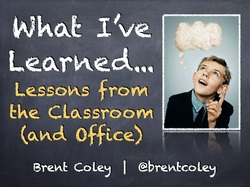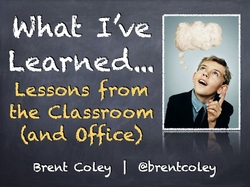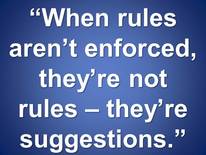
One of the great things about Google Forms is that the information submitted through the form is populated in a spreadsheet. All the data in one location, easily sortable. You can even share the spreadsheet with others so they can see and use the information.
But as great as spreadsheets are, somethings they can be a little overwhelming to view, especially if they are filled with many fields containing a lot of information. What if you wanted each form response recorded in a separate, well-organized document, a document that could automatically be created and saved in your Google Drive as well as sent to the person who submitted the form? Enter the free Google Sheets add-on autoCrat. As I wrote in a previous post, my teachers use two Google Forms to submit their agendas for and notes from their weekly Professional Learning Community (PLC) meetings. With autoCrat, not only will I receive the submitted information in the forms' corresponding spreadsheets, but now both the teachers and I will receive the agendas and notes in separate, printable, easy-to-ready documents. To see exactly how to use autoCrat and how it can take your Google Forms and Sheets to the next level, watch the tutorial below. Hope it's helpful!
0 Comments
 Over the course of my career in education, I've learned numerous strategies and received countless tips and pieces of advice on how to be a great teacher. So many things go into being an effective educator, and in this post I want to share one small thing I learned way back in 1994. I was taking a college course on physical education for prospective teachers, and one day the instructor shared with the class what I consider to be one of the simplest yet best teaching tips I've ever received. The class was meeting outside on the grass field one day, and before beginning her lesson, the instructor looked up into the sky, adjusted where she was standing in relation to the students, and then told the class something I've never forgotten -- "Never have your students face the sun." So simple, yet so powerful. Think about it. You're outside with your students giving them directions about an activity the class is about to begin. If your students are looking into the sun, they're more than likely going to be distracted by the blinding light of that large fireball in the sky. They're probably thinking, "Man, this sun is bright!" If they're distracted by the sun in their eyes, they're not completely listening to you. They may be quiet, but through squinted eyes, they're probably not fully engaged. Plus, it's simple courtesy. You have sunglasses, your students don't. We learned at a young age not to stare at the sun. Let's not make our students do so when our classroom is the great outdoors.  I recently heard a story about three high school siblings who experienced a rarity in education -- all three students had the same teacher during the same semester. Different grade levels and different classes, but they all had the same teacher. For the sake of this story, we'll call him Mr. Smith. One day, the three students' parents received a phone call from Mr. Smith letting them know that one of the students had fallen asleep during his class that day. Of course, this led to a conversation that evening between Mom, Dad, and the sleepy student. When the other two children, both well-behaved and high-achieving students, heard about what had happened, each of them shared their thoughts on the matter by saying, "I wish I could sleep in Mr. Smith's class." So here's a question. How many of the three students would you say were engaged during Mr. Smith's class? For this question, we'll define engaged as being "into" the lessons being taught. How many students? Two? The ones not sleeping in class? I contend that the answer is probably zero. None of the students. Yes, the other two students weren't sleeping in Mr. Smith's class, but why not? Because they were engaged by his lessons? No. Both students indicated this wasn't the case, stating they wished they too could catch a few winks during Mr. Smith's class. No, more likely, the students weren't sleeping in class because they're "good" students who've been taught that sleeping in class is a no-no. Good students are supposed to pay attention in class, follow directions, and complete assignments on time. Because that's what good students do. How often do we as educators mistake compliance for engagement? How often do we misinterpret quiet, on-task behavior as genuine engagement? Integrity has been defined as how one acts when no one is watching. Genuine student engagement is like integrity -- it will continue to be present even when the teacher isn't watching. Have you ever taught a lesson your students were so into that they lost track of time, forgetting they were supposed to go to recess or lunch? Think of those times when students asked to continue learning not because they had to but because they wanted to. That's the goal. That's genuine student engagement. When I was teaching, I'm sure there were times when I mistook compliance for engagement. I had good classroom management. I ran a fun, structured classroom where students followed the rules and were on task. But does that mean all of my students were engaged, really "into" the learning, all of the time? Unfortunately, no. How often did I observe simple compliance from my students because I failed to truly engage them? How often did I observe counterfeit engagement? Genuine student engagement occurs when a teacher is deliberate in his/her attempt to involve students in their learning, rather than simply treating them as passive vessels into which we pour knowledge. It occurs when students take ownership of their learning. It occurs when worksheets are replaced with meaningful tasks, when students are asked to create rather than complete. It occurs when students aren't asked to always sit through a lecture but are instead allowed to use technology to collaborate and connect with their peers, to learn together. How will you genuinely engage your students today?  What's in a name? This is an expression we've all heard before, but what's the answer? Are names important? In this fourth video of my "What I've Learned" series, I share two of my experiences, one from a teacher's perspective and one from an administrator's point of view. Through these short stories, you'll see that a person's name isn't just important, it's powerful. If you haven't yet watched the first three videos in the series, you can do so by visiting the "What I've Learned" page. If you've already seen them, I welcome your feedback.  Here's the second story in my new series "What I've Learned...Lessons from the Classroom (and Office)." In this video, I share an experience from my very first year of teaching. While it was definitely not one of my prouder moments (as you'll see in the video), I learned an extremely valuable lesson about the kind of teacher I want to be. I hope you find my story to be helpful. If you haven't yet watched the first video in the series, you can do so by visiting the "What I've Learned..." page.  Ever felt like you're the only one or one of only a few trying to enforce a rule? You've been told students need to behave a certain way, you do your best to be consistent in holding them accountable, but those around you seem to "let things go?" It's frustrating. That feeling of "I can't do this alone" sets in. You think it’s impossible, like standing knee-deep in the ocean, hands stretched toward the horizon, trying to stop the tide. I've asked myself why this happens. Why do teachers "let things go?" Why is there often a lack of consistency in enforcing rules? I think there are several reasons, but one can be summed up in the comment I've often heard -- "It's not worth the fight. I'm not going to die on that hill." Here's my take on that mindset. First of all, it is worth the fight. Anything in the best interest of the kids we serve is always worth the effort. Secondly, who said you have to die? If you're the only soldier fighting on the hill, yeah, chances are, you're going to die. But if everyone fights on the hill, no one has to die. If you're the only one trying to enforce a rule, the only one trying to change the culture of your work place, you're in for a tough fight. But what if others came alongside and fought with you? What if you had an army? Imagine what you could accomplish by working together. Finally, some things are worth fighting for, and if necessary, metaphorically dying for. There are times in life, in your career, when you may feel like you're the only one who is fighting. There may be times when you feel alone, like you're the only one enforcing the rule. If this is the case, I encourage you -- don't give up! When my students had a difficult time following directions, being responsible, or behaving appropriately, and I had to constantly remind and redirect them, I would often say, "Class, it would be much easier for me to stop holding you accountable. But that wouldn't be what's best for you." Sometimes you have to fight, because that fight is what's best for kids. But you don't have to fight alone.  Those who know me personally know that I am a rule follower. Always have been, always will be. I think rules are important. Very important. Heck, when I text, I spell out all words, use proper punctuation, and capitalize appropriately. Why? Because those are the grammatical rules I was taught. I've been teased for my firm stance on adhering to rules. I've been told, "Lighten up, Brent. Don't be such a stickler." Here are my thoughts on the subject... Rules must be followed. When rules aren't enforced, they're not rules -- they're suggestions. If there is no consequence for not following a rule, then it's not a rule, because rules must be followed. Suggestions, on the other hand, are things we'd like people to do, not expect them to do. If you're not going to enforce a rule, get rid of it. A good rule is not arbitrary. Rather, it is put in place for a specific reason. From the time we were small children, we've had safety rules guiding our behavior. Don't run with scissors. Look both ways before crossing the street. Don't stick objects in an electrical outlet. All common rules there for our protection. Rules must be enforced by everyone in the organization. Inconsistent rule enforcement sends the wrong message. For example, fighting is prohibited in all schools, and I think it's pretty safe to say this is a rule that is consistently enforced. But what about, say, a "no gum" rule? If Teacher A enforces the school's "no gum" policy but Teacher B allows students to chew gum, what is the result? First, Teacher A is going to be perceived as the "bad guy" for not allowing students to chew gum. Second, students are sent the message that some rules are important (no fighting) and some aren't (no gum), and that they get to choose when and where they follow certain rules. Yes, there are major and minor categories of rules, but all rules should be important. That's why they're rules. Beware of the danger in suspending rules. When a rule is suspended ("Today you don't have to follow the rule"), it compromises the integrity of the rule. Again, it sends the message to students that on every other day, the rule is important, but not today. This is why I never used homework passes. I didn't want to send my students the message that homework is important and must be completed unless you have a pass. I felt that suspending the rule on homework would undermine the importance of the activity. The Three C's: Clarity, Consistency, and Consequences. Without these three things, students can't be sure of what to expect. Regardless of whether or not they'll admit it, students want (and need) rules. They want the structure and security rules provide. Clarity, consistency, and consequences are imperative, because without them, a fourth C is produced -- confusion. So now I must ask myself this question -- "Are all of my rules, both at school and at home, good rules?" Something to think about. Thanks for reading. |
About BrentBrent has worked in the field of education as a teacher and administrator for 28 years. A former elementary school teacher and principal, he is currently Coordinator of Elementary Education in the Murrieta Valley Unified School District in Southern California. Read more about Brent here. Brent on X (Twitter)Archives
May 2024
Categories
All
|
Photos from somegeekintn, woodleywonderworks, Joybot, British Council Singapore, jseliger2, berkuspic, toddwendy, Alexandra E Rust, skippyjon, crdotx, tharrin, roybuloy, .FuturePresent., Just some dust, frankpierson, Jair Alcon Photography, Luigi Mengato, Muffet, stevendepolo, Pilar Soro, Sander van der Wel, jblyberg, jonathangarcia, DraXus, angeloangelo, Sthetic


 RSS Feed
RSS Feed
